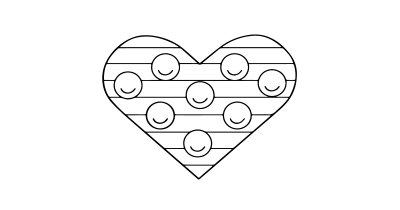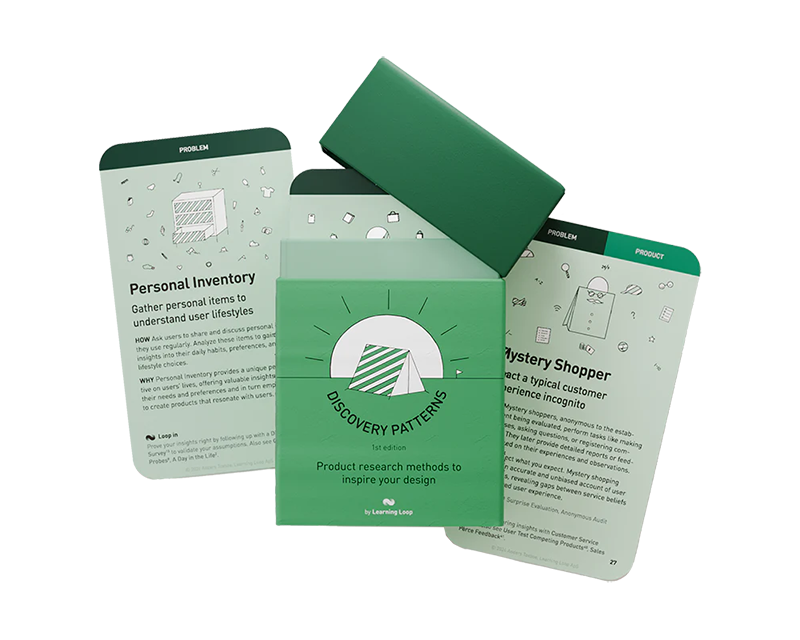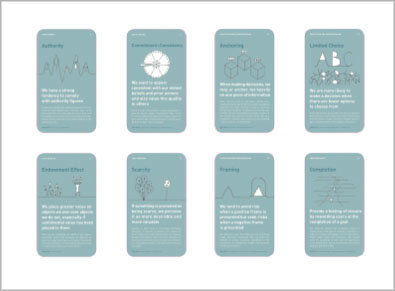Idea Validation: Problem, Market demand, Product, Willingness to pay
Customer Discovery Program
Recruit reference customers as discovery partners

How: Identify 6-8 prospects or customers from a single market, who use your product, love it, and ready to publicly endorse it. Recruit them as discovery partners and public references - if they are satisfied with the product.
Why: In B2B and B2B2C settings, recruiting end-users for discovery and testing can be challenging.
Customer Discovery Programs are structured initiatives that create ongoing, strategic feedback loops between companies and their customers. They go by many names: Customer Advisory Boards, Customer Councils, Customer Development Programs, or Pilot Programs – but they share a common goal: to place customer insights at the center of strategic product and business decisions. These programs are not transactional. They are designed to develop long-term partnerships, uncover deep insights, and validate decisions across product, marketing, and growth functions.
“Customer Discovery Programs are built for sustained engagement”
Unlike focus groups or usability tests, which are often tactical and short-term, Customer Discovery Programs are built for sustained engagement. They invite select customers into the strategic process, giving them a seat at the table while helping companies refine their offerings and strengthen relationships. Done well, these programs not only shape better products but also foster trust, loyalty, and advocacy.
Their main purpose is facilitating co-creation
At their core, Customer Discovery Programs are a way for product teams and executives to co-create the future with their customers. They enable organizations to validate strategic direction, co-develop roadmaps, and anticipate shifts in user needs. In B2B contexts especially, participants in these programs often represent a company’s largest or most influential accounts. They bring market intelligence, peer insights, and candid feedback that helps teams align what they’re building with what customers actually need.
A well-run discovery program supports the development of a shared vision for the future. It elevates customer voices into product, marketing, and leadership decisions—not only to build better products but to foster lasting loyalty and trust. CAB members are often more likely to become brand advocates, and data suggests they generate, on average, 9% more new business compared to non-participating customers.
Designing a Customer Discoery Program
The structure of a discovery program depends on its purpose and the maturity of the organization. Some companies run formal Customer Advisory Boards composed of 10–15 carefully selected executives from client organizations, convening 1–2 times per year for in-depth strategic dialogue. Others use rolling or pilot-style programs, where smaller customer groups participate in roadmap reviews, product betas, or opportunity exploration.
Member selection is critical. The most effective programs match participants by stature—ensuring that all members operate at similar decision-making levels within their organizations. This creates an environment of peer exchange, where ideas are shared openly, and value flows both ways. Selection should also ensure diversity in customer type, geography, industry, or use case to provide a holistic view of your market.
A compelling theme helps focus the program. It might be centered on a shared industry challenge, a transformation initiative, or a new product domain. Agendas should be shaped collaboratively—with input from customers—to ensure relevance and mutual benefit. A mutually beneficial agenda invites strategic conversations while giving customers the opportunity to influence features, services, and go-to-market decisions.
The cadence of interaction also matters. While CABs may meet bi-annually, continuous discovery programs aim for more regular engagement—such as monthly check-ins, rolling feedback sessions, or weekly customer interviews. This aligns with the continuous discovery mindset where product teams, often operating as a trio (PM, designer, engineer), engage customers every week to explore assumptions and co-develop ideas.
Successful discovery programs tend to share some of the same traits:
- They are anchored by strong executive sponsorship. Senior leaders must actively participate, not just observe. Their involvement signals that customer feedback has strategic weight.
- They commit to active listening and follow-through. Customers must see that their input leads to action—or at least transparent reasoning for why something isn’t pursued. This builds credibility and keeps participants invested.
- They embrace structured facilitation. Many effective CABs use workshop techniques, breakout discussions, or OST visualizations to guide dialogue. Visual methods help participants map opportunity areas, challenge assumptions, and identify blind spots collaboratively.
- They build for continuity. Ongoing touchpoints—like progress updates, mini check-ins, or shared action logs—keep momentum between formal meetings. This continuous connection supports co-ownership of strategy.
Integrating Discovery Programs with Continuous Product Discovery
Customer Discovery Programs become especially powerful when integrated with a team’s product discovery practice. By weaving CAB and pilot program insights into weekly discovery rituals, teams can continuously test assumptions, validate opportunities, and iterate faster. Tools like the Opportunity Solution Tree help teams track the journey from customer-stated needs (opportunities) to implemented solutions, always linked back to strategic goals.
The CAB environment is also a rich source of opportunity discovery. Customers surface both urgent pains and aspirational goals, which teams can map into OST branches and explore through interviews, prototypes, or experiments. These discussions help ensure that discovery work is grounded in real, market-relevant context rather than internal speculation.
Outcomes and strategic impact
When executed well, Customer Discovery Programs yield clear business value:
- They validate strategic direction by surfacing how your initiatives align with (or diverge from) customer priorities.
- They shape product development by ensuring roadmaps reflect actual use cases and unmet needs.
- They improve marketing and sales messaging by revealing the language and framing that resonate with decision-makers.
- They build strong customer relationships that lead to higher retention, expansion, and advocacy.
- They reveal competitive intelligence—participants often share what’s working (or not) with other vendors in your space.
Customers benefit too. They gain early influence over product direction, access to innovation pipelines, and opportunities to benchmark and network with peers.
“These programs bring the voice of the customer into the heart of decision-making”
Whether in the form of a formal Customer Advisory Board, a rolling pilot group, or a continuous interview loop, these programs bring the voice of the customer into the heart of decision-making.
By integrating them with continuous discovery habits and tools like the Opportunity Solution Tree, product teams create a powerful feedback engine that drives clarity, confidence, and customer-centric growth. The result is not only better products, but stronger partnerships, more resilient strategies, and a culture that values insight over assumption.
Measuring success
Success in a Customer Discovery Program can be measured by the number and quality of customer problems identified and solved, the feedback obtained, and the referrals made by your discovery partners.
These measures should not be seen as mere statistics, but as indicators of the value of your program. A decrease in customer problems, for instance, could indicate that your product is becoming more user-friendly or that your customer support is improving.
Remember, the program’s ultimate aim is to build a better product that meets your customers’ needs. So, the best measure of success is the degree to which this goal is being achieved.
Popular tools
The tools below will help you with the Customer Discovery Program play.
-
Maze
Supports creation and management of user panels for targeted testing. Teams can segment CAB members or pilot users and involve them in continuous concept validation, usability testing, and surveys.
-
Preely
Includes a built-in panel management feature where teams can recruit, segment, and continuously engage with test participants—ideal for structured discovery or advisory loops.
-
Great Question
Combines panel management, interview scheduling, and research tracking in one platform. Lets you build advisory cohorts, tag by persona or behavior, and keep them engaged in continuous discovery.
Real life Customer Discovery Program examples
Lenus eHealth
The B2B2C fitness coaching platform selling to coaches who had clients struggled to get access to paying clients of their customers. To solve this problem, they set up a Coach Advisory Board granting early access to new features for being available for 4 interviews per year and letting Lenus eHealth recruit 5 of their clients a year for testing.
Danish Broadcasting Corporation
The national broadcaster formed a “user panel” with 10k+ Danes from all demographics of the population. Participants, who opted in to be contacted, provided feedback on a wide range of topics, from TV shows to product development efforts. This direct user input informed their content and product development.
HubSpot
HubSpot runs a Customer Advisory Board to engage its most active and strategic customers. The board provides ongoing feedback on roadmap priorities and product experience, especially across its CRM and marketing platforms. Advisory members are invited to private roadmap sessions and contribute to early-stage concept validation.
Source: offers.hubspot.com
SAP
SAP’s Enterprise Support Advisory Council enables customers to co-innovate and provide input on SAP’s support offerings and product strategy. Participating organizations engage in pilot projects and provide structured feedback, directly influencing the evolution of SAP’s enterprise solutions.
Source: support.sap.com
A collection of clever product discovery methods that help you get to the bottom of customer needs and coining the right problem before building solutions. They are regularly used by product builders at companies like Google, Facebook, Dropbox, and Amazon.
Get your deck!- Customer Advisory Board by ProductPlan Editorial Team at ProductPlan
- Customer Advisory Board by Ignite Advisory Group at Ignite Advisory Group
- Continuous Discovery Habits by Teresa Torres at Mind the Product
- Customer Advisory Council by Wikipedia contributors at Wikipedia
- Customer Advisory Boards: A Catalyst For Customer-Centric Innovation by Forbes Technology Council at Forbes

